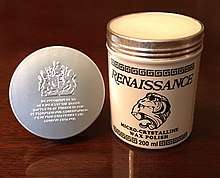Renaissance Wax
Renaissance Wax is a brand of microcrystalline wax polish used in antique restoration and museum conservation around the world. Commonly used to polish and conserve metal objects, it is also used on gemstones and such organic materials wood, ivory, and tortoiseshell. The product is sometimes used by reenactors to protect armor and weapons. Waxes are more protective and longer-lasting than oil, especially for swords and helmets that are frequently touched by human hands.[1] It has recently been introduced in the world of guitar building, as a finish that protects and gives colour to the wood.


Wax coatings for conservation are most widely, and least controversially, applied to metals. This has several objectives: to produce a barrier that excludes moisture and oxygen from the metal surface, to preclude the introduction of contaminating elements by handling, and to provide a protective layer over anti-corrosion undercoatings.
Microcrystalline waxes used on ethnographic metal objects are discouraged, as they may require extensive treatment for removal.[2]
Renaissance wax is used to protect metals such as silver, brass and copper from tarnishing, on collections of all types of metals (old coins, locks and keys, arms and armour both original and replica), on both the wood and metal surfaces of vintage cars and musical instruments, on bronze sculptures inside the home and outside exposed to the elements, on marble and granite worktops to prevent staining and on smooth leather items[3].
Formulation
Renaissance Wax was developed in the British Museum Research Laboratory by Dr A E A Werner[4] in the late 1950s. It is manufactured by Picreator Enterprises Ltd.[5]
Earlier wax polishes based on beeswax and carnauba wax either contained acids or became acidic over time. Renaissance Wax is based on more stable microcrystalline waxes refined from crude oil.[6]
Renaissance Wax contains polyethylene waxes. Some other microcrystalline waxes intended for conservation use do not contain these.
See also
- Conservation-restoration of cultural heritage
References
- "Chinese Swords Guide: Restoration".
- Moffett, Dana L. (1996). "Wax Coatings on Ethnographic Metal Objects: Justifications for Allowing a Tradition to Wane". JAIC. 35 (1): 1–7. doi:10.2307/3179934. JSTOR 3179934.
- "Picreator Enterprises LTD | Renaissance™ Wax". Retrieved 2019-11-29.
- Who's Who, 1998, p. 2099
- "Renaissance Wax". Picreator Enterprises Ltd. (Manufacturer). Retrieved 2007-04-27.
- Horie, C V (1996). Materials for Conservation. Elsevier Science and Technology. ISBN 0-7506-0881-1.